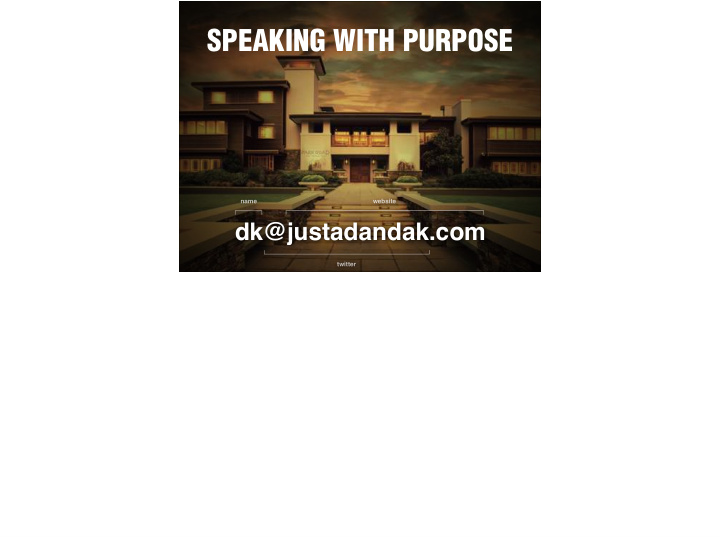



SPEAKING WITH PURPOSE name website dk@justadandak.com twitter
STOP https://unsplash.com/photos/C5ORgbT2kGk What are you hoping to get out of the sessions?
WHO justadandak.com / http://justadandak.com/sandbox-summit-2015-closing-keynote-getting-mit-dancing/
EFFECT http://tedxwellington.com
WORK "If I am to speak for ten minutes, I need a week for preparation; if fifteen minutes, three days; if half an hour, two days; if an hour, I am ready now." Woodrow Wilson https://en.wikipedia.org/wiki/Woodrow_Wilson#/media/File:President_Wilson_1919.tif Speaking is a craft and requires work.
FOCUS https://unsplash.com/photos/1eWaod96d3k/ Here’s some top tips and a framework to give your talks a focus.
FRESH It stays fresher in your brain than if you completed it a few weeks previous. This is important for my industry as stu fg moves so quick but it also o fg ers the opportunity to add in references from earlier talks (if it’s more than a one day event) plus ensures you can omit things which have already been covered. Most importantly though it doesn’t give you a chance to practice… https://unsplash.com/photos/S3gNA0HQZo8
PRACTICE A great talk is like a conversation (and no conversation goes the way you planned, no matter how many times you practice it in your head). Sure, run through it once to check the timings plus transitions etc but this is more an exercise of knowing what you want to convey rather than rehearsing exactly what to say verbatim. https://unsplash.com/photos/inCiuLNuwdw
DON’T It forms a physical barrier between you and your audience. Less is definitely more in this instance and before you say, “where do I put my script…?” https://unsplash.com/photos/PIQCA1ReSgU
NO If you know your stu fg you don’t need it written down. This method means: head down, losing intonation / connection with your audience / professionalism. We don’t talk the same way we write and it just doesn’t work. If you’re an organiser of any events / conferences, ban podiums and scripts. It will scare a lot away but I guarantee you’ll be left with fantastic speakers who simply know their stu fg . https://unsplash.com/photos/CxYHfBkC0vs
CONTROL https://unsplash.com/photos/CuFYW1c97w8 Let your client dictate the topic not the content—I once had a very needy client who heavily dictated the content of a presentation I was giving at their event to the point of even signing it o fg . It’s the ONLY time the organisers didn’t think I delivered (even though three quarters of the audience thought I was good/very good). Coincidence maybe, but experience tells me otherwise.
MOVE https://unsplash.com/photos/cF6fz9QwfrY Move—the best speakers are passionate and passion means movement. Move around the stage / floor. Move your arms, your face, your eyebrows. Communicate with your body not just your words / slides.
LOOK Look at your audience—engage them through eye contact. Don’t pick a spot at the back of the room / hall and drift o fg . Sometimes this is hard if you’re speaking on a lit stage but you can still make people out. After a while you can have some fun with this: I like to pick out those yet to be convinced (you’ll spot them through body language—the ones with their arms crossed and sitting back in their seat—once you have them coming forward and sitting on the edge of their chairs and nodding their heads you know you’re onto a winner). https://unsplash.com/photos/kxxL-EhOlBU
ATTENTION Bullets kill people—well maybe in this case it’s attention. People can read faster in their heads than you can read it out loud. The only words I use in my presentations are the titles for each slide. This directs my talk. They act as cues for the topics or a point I want to convey. The underline comes from the images/video plus the story weaved around it. https://unsplash.com/photos/KGRZFB1U25I
FEAR Fool your nerves—those damn butterflies can turn into courage-eating moths which can eat you from the inside out. Trick them. The emotional and physiological response to fear is exactly the same as when you’re excited. Tell yourself it’s not nerves but positive anticipation and after a while you will create an ingrained learned response. https://unsplash.com/photos/ea9Zg7HkFXQ
CRAZY Enjoy it—if you don’t have fun speaking then don’t do it. There are other ways to promote yourself or spread your message. https://unsplash.com/photos/qZAwt2OHKaA
STRUCTURE context content conclusion A simple framework for building talks.
QUESTIONS Question time. https://unsplash.com/photos/i--IN3cvEjg
CRAFT Why is your favourite film your favourite film? Your time - your mission is to craft a talk for next weeks session answering: what is your favourite film and why? https://unsplash.com/photos/Tq4YjCa2BSc
FRAMEWORK context content conclusion The framework from which you can build your presentation - 30secs per slide.
Recommend
More recommend